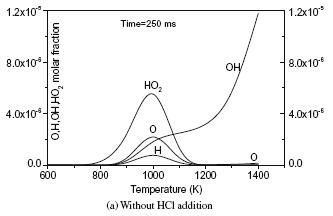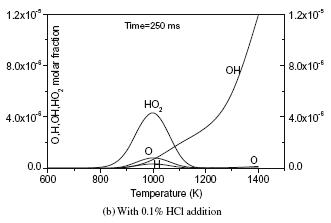The influence of HCl on CO and NO emissions was experimentally investigated in an entrained flow reactor (EFR) and an internally circulating fluidized bed (ICFB). The results in EFR show the addition of HCl inhibits CO oxidation and NO formation at 1073 K and 1123 K. At the lower temperature (1073 K) the inhibition of HCl becomes more obvious. In ICFB, chlorine-containing plastic (PVC) was added to increase the concentration of HCl during the combustion of coal or coke. Results show that HCl is likely to enhance the reduction of NO and N2O. HCl greatly increases CO and CH4 emission in the flue gas. A detailed mechanism of CO/NO/HCl/SO2 system was used to model the effect of HCl in combustion. The results indicate that HCl not only promotes the recombination of radicals O, H, and OH, but also accelerates the chemical equilibration of radicals. The influence of HCl on the radicals mainly occurs at 800-1200 K.


Fig. 8 Concentrations of radicals with varied temperature in gas combustion.
This paper was published as:
Wei XL, Wang Y, Liu DF, Sheng HZ. Influence of HCl on CO and NO emissions in combustion. Fuel,88(10):1998-2003(2009)